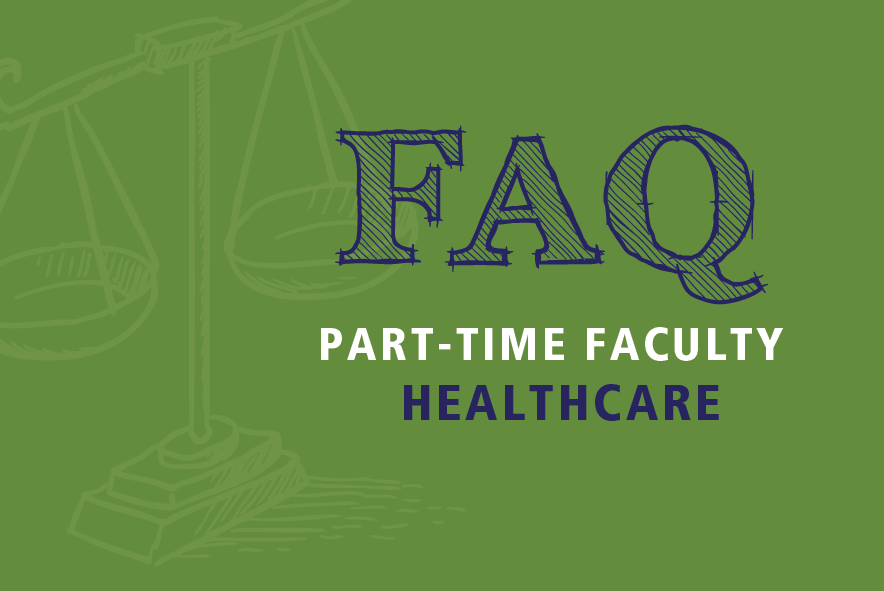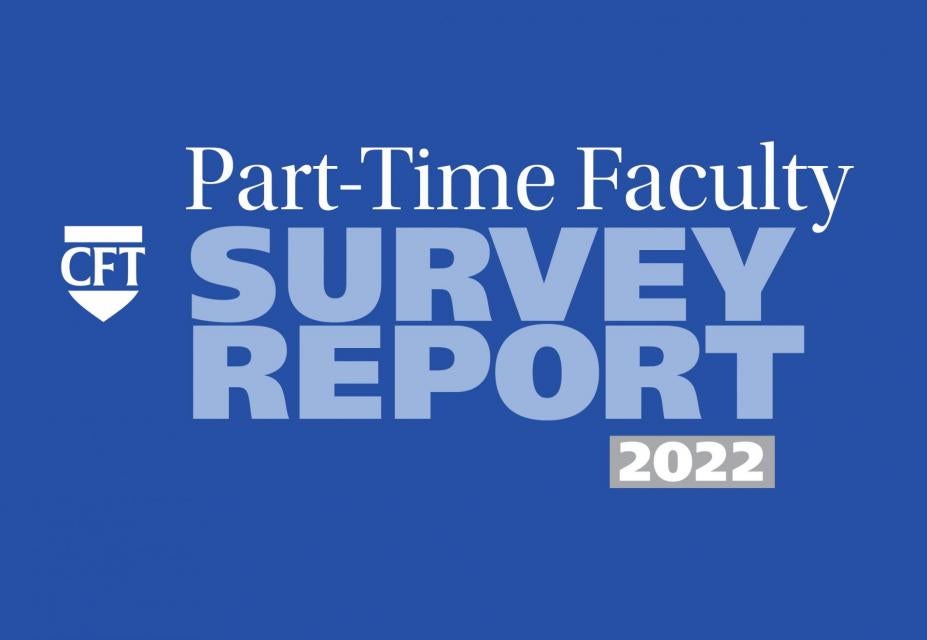Updated July 1, 2022
About half of the California community college districts offer healthcare benefits for part-time faculty; the quality of the benefits is wide ranging with some offering the same benefits package to full- and part-time faculty and some offering very modest stipends to help cover the cost of insurance.
In all cases, there are employment thresholds that part-time faculty must meet in order to qualify for the benefits and in some cases this eligibility bar is very high. Some districts cover the full cost of plans, while others cover a fraction or less.
CFT members are leading a campaign to improve health insurance benefits for part-time faculty by:
- Increasing access to benefits
- Reducing cost for employees
- Ensuring benefits are high-quality plans
- Removing obstacles for faculty who teach in multiple districts.
This Q&A is meant to help demystify how part-time healthcare is funded, the state budget proposals under consideration, and the changes CFT is advocating for during the 2022-23 state budget process.
How does the state of California currently fund healthcare for part-time faculty?
California has a Part-Time Community College Health Insurance Program established in 1996 to encourage community college district to offer health insurance to part-time faculty. The Education Code (Sections 87860 through 87868) states, “It is the intent of the Legislature that part-time community college faculty and their eligible dependents have continuous access to health insurance benefits.” (See the CFT resolution in support of a permanent program.)
The program was set up to incentivize districts to offer health insurance by reimbursing districts for up to half of the costs incurred by the district. When the reimbursable costs exceed the funding available, reimbursement amounts are reduced proportionate to the employer’s costs.
The program has been extremely underfunded, at $490,000 per year. As a result, districts are only reimbursed for about 4% of their costs, instead of the allowable 50% reimbursement (i.e. no district is receiving 50% now).
However, many districts offer healthcare benefits to part-time faculty using public funds allocated to the districts outside of this program – the same way the fund benefits for all other employee groups.
Can the districts be reimbursed for dependents, dental, and vision?
The reimbursement program will cover healthcare for dependents, but will not cover premiums for dental or vision coverage. In addition, the program only covers faculty who are employed on a 40% or greater appointment.
Does this mean the colleges cannot offer dental or vision benefits, or benefits to faculty who are employed at less than 40%?
No! The college can offer any of these benefits, however the costs associated with these would not qualify for reimbursement from the statewide program. Some districts do offer dental and vision benefits to part-time faculty and some districts offer healthcare benefits to faculty who are employed at less than 40%.
Besides the statewide health insurance program, how are healthcare benefits funded?
About half of the state’s districts offer healthcare for part-time faculty (using their discretionary funds to cover the costs). The benefits are negotiated through the local collective bargaining process.
Altogether, the 72 districts spend around $25-30 million per year on part-time healthcare. In 2020-21, district reimbursement claims to the State Chancellor’s Office show that districts spent a total of $25.4 million on healthcare benefits that qualified for reimbursement under the program; in 2019-20 the amount reported was $26.9 million (the actual amount spent was more than this, as not all districts submitted claims).
Does the statewide reimbursement program require districts to offer healthcare benefits to everyone who is working 40% or more?
No, the eligibility thresholds are determined locally at each district, and through collective bargaining. The program, as defined in the Ed Code, will not reimburse any cost of benefits for people working less than 40%. However, since the program historically has not reimbursed districts for anywhere close to half of the employer costs, this has minimal practical impact.
The eligibility thresholds vary widely from district to district. The value and quality of the benefits offered also vary widely. Several districts offer excellent healthcare benefits to faculty who work 50% for at least one year; at other districts the faculty member must work for two years. At some districts, the employer covers all or nearly all of the cost of the premium, and at some districts, the employer covers only half or less of the premium.
What is the $200 million proposal for the 2022-23 state budget?
The CFT has been advocating for state funding to support part-time faculty healthcare, and Gov. Newsom included a proposal in the January budget to increase funding for the currently existing program by $200 million. This is a tremendous increase, since the current funding is only $490,000. The governor’s May Revision budget also contains the $200 million proposal. The next step in the budget process is for the Assembly and Senate to include the $200 million in their budget proposals. If this happens, the final budget is likely to include the $200 million.
The proposal, as written, calls for the current program funding to be increased by $200 million, but it does not change the restrictive rules of the program. Therefore, CFT is also advocating for program changes and stronger incentives for districts. These changes would support bargaining conditions for locals to negotiate significant healthcare expansion for part-timers.
If the governor’s $200 million proposal is in the final budget, without any program changes, what does that mean for part-time faculty?
First, $200 million would be more than enough money to reimburse districts for the full 50% of their qualifying part-time healthcare costs. This means the discretionary funds the district is currently using to cover these costs would become freed up and could be used to fund other things. For example, last year the districts were eligible to receive $12.7 million (total); the year before it was $13.5 million.
With the existing rules, then, at least $13-14 million per year would be freed up in district budgets.
Without the program changes, employers may still refuse to agree to improvements to healthcare benefits for part-time faculty. Since the $200 million will not automatically expand access to high quality healthcare, the changes are critical and if we are successful, they will significantly strengthen local bargaining conditions.
What are the changes that CFT is proposing for the program?
CFT is proposing changes that would result in more part-time faculty gaining access to better and more affordable healthcare benefits. CFT is calling for modifications to the program that would create additional incentives, i.e., funding to employers who provide benefits that are above and beyond the current minimum requirements. Specifically, CFT is advocating for program changes so that districts could be reimbursed for more than half of their costs (which is the status quo) when the healthcare benefits:
- are available to all faculty who are employed at 40% or more;
- are available immediately without a semester or year waiting period;
- are equivalent or the same as the benefits offered to full-time faculty; and
- when the employee is responsible for no more than 10% of the premium costs.
In addition, CFT is calling for a mechanism that would allow faculty who teach at multiple districts to combine their appointments to qualify for benefits or reimbursements for healthcare costs.
Will $200 million be enough to really improve healthcare for part-time faculty?
Yes. Using data about current healthcare benefits costs, participation/enrollment, and benefits offered reported by the Chancellor’s Office, the CFT did a costing analysis. The analysis identified the top five districts that offer high-quality healthcare benefits and where the employer covers all or most of the costs; in these examples, the healthcare benefits for part-time faculty are the same as those offered to full-time faculty.
Then, we estimated the cost of offering similar benefits packages throughout the state. The analysis includes several scenarios, which vary by the percentage of part-time faculty enrolled and by how the cost is split between employer and employee. The costing analysis shows that $200 million would be sufficient to cover healthcare benefits costs associated with the expansion of access and quality imagined with the proposed programmatic changes.
UPDATE JULY 1, 2022 — What happened to the $200 million budget item?
CFT’s advocacy was instrumental in winning $200 million for the part-time faculty healthcare program! The $200 million was included in the 2022-23 budget signed by Governor Newsom on June 30.
Although the program changes were not included in the June budget bills, the budget includes language that asserts the Legislature’s intent to modify the program. CFT advocates will continue to engage with legislators and the governor’s office over the next few weeks and we will hopefully see the important program changes codified in a budget trailer bill in August.
What exactly does the budget say about the program changes; what can we expect?
The budget language is known as “intent language” and it does not spell out any specific changes, but it is an important development. Specifically, the budget states, “SEC. 51. It is the intent of the Legislature to consider changes to the Part Time Faculty Health Insurance Program to achieve parity between part-time faculty and multidistrict part-time faculty, maximize the State of California’s investment in this program, and incentivize more community college districts to provide quality and affordable medical care coverage to part-time faculty and multidistrict part-time faculty.”
It is not unusual for some budget issues to be finalized in the weeks following the main budget actions, so CFT is prepared to keep up the pressure and momentum to achieve much needed improvements to the program.
What’s next?
CFT will continue to advocate for the program changes to significantly expand access to affordable, high-quality healthcare for part-time faculty. With the $200 million included in the budget, local unions will continue preparing bargaining proposals and gearing up to negotiate for improvements to healthcare benefits for part-time faculty.


